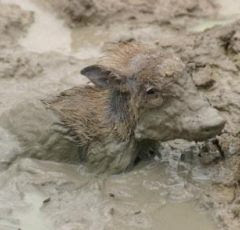Jochi's armies, masterminded by General Subutai and commanded by his sons Batu Khan and Kadan, continued the conquest of the territories would become the Jochid Ulus part of the Golden Horde empire including Crimea, Ukraine and Kievan Rus the biggest city in eastern Europe then and capital of what we now call Russia.
The Mongols invaded and destroyed Volga Bulgaria and Kievan Rus', before invading Poland, Hungary and Bulgaria, and others. Over the course of three years (1237–1240), the Mongols destroyed and annihilated all of the major cities of Eastern Europe with the exceptions of Novgorod and Pskov. Along the way many thousands of nomadic tribesmen joined the Mongol armies for a variety of reasons including the spoils of war, philosophical agreement with Mongol traditions and the thrill of victory over longtime enemies. The largest groups to join Jochi Khan's armies were the Tatars and the Turkic tribesmen from what is now Kazakhstan.
The vast Mongol hordes of around 35,000 mounted archers, 20,000 Tartars and 80,000 Turkics, commanded by Batu Khan and Subutai, crossed the Volga River and invaded Volga Bulgaria in the autumn of 1236. It took them a year to extinguish the resistance of the Volga Bulgarians, the Kipchaks/Cumans and the Alani. In the summer of 1238, Batu Khan devastated the Crimea and pacified Mordovia. In the winter of 1239, he sacked Chernigov and Pereyaslav. Then turned their attention on Kievan Rus' the largest city in Eastern Europe at the time and the capital of what we now call Russia.
During the invasion of Kievan Rus', the Mongols used the frozen Dnieper's river as a highway. Winter, the time of year usually off-limits for any major activity due to the intense cold, became the Mongols' preferred time to strike. The Siege of Kyiv [the Tatar Yoke] by the Mongols took place between November 28 and December 6, 1240, less than a week. Chinese engineered siege engines[catapults] were used by the Mongols to raze the walls of Kiev.
Out of 50,000 inhabitants before the invasion, about 2,000 survived. Most of the city was burned and only six out of forty major buildings remained standing. Huge cities such as Kiev took centuries to rebuild and recover from the devastation of the Mongol's attack. The victory by Batu and Kadan allowed them to proceed westward into Europe.
Under Genghis's successor Ögedei Khan the speed of expansion reached its peak. Jochi's armies got as far as the gates of Budapest in Hungary, and the only reason they turned back in 1241 was because the Great Khan Ogedei died and they had to go back to choose his successor.
The Ulus of Jochi in 1241
Without Jochi's agreement to accept his brother Ogedei as Great Khan the Mongol destruction of Kievan Rus' that the Tsardom of Russia, and subsequently the Russian Empire, would not have arisen. Trade routes with the East came through the Rus' lands, making them a center for trade from both worlds. In short, the Mongol conquests, while destructive in the extreme to their enemies, had a significant long term effect on the rise of modern Russia, Ukraine, Crimea and Belarus.




